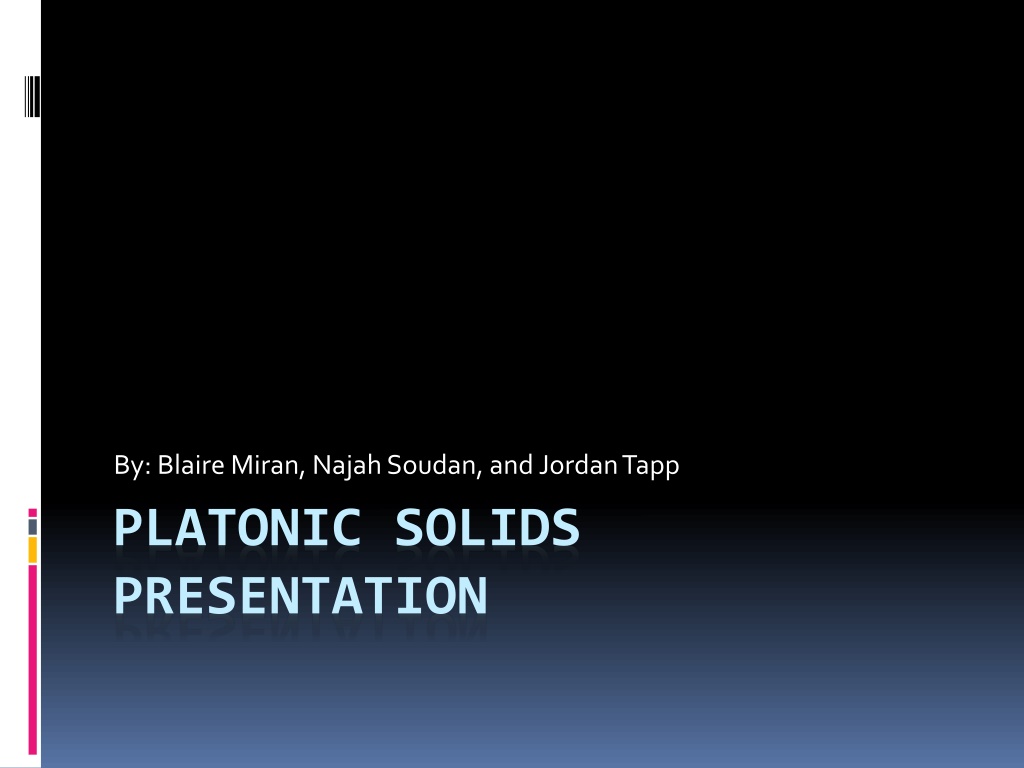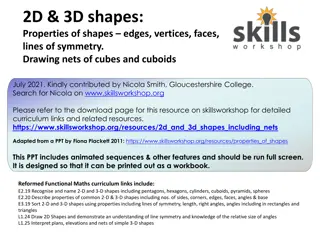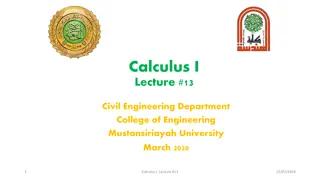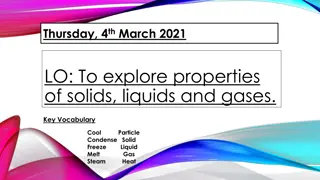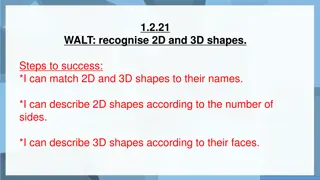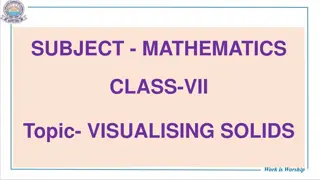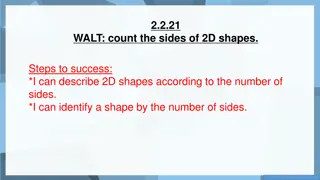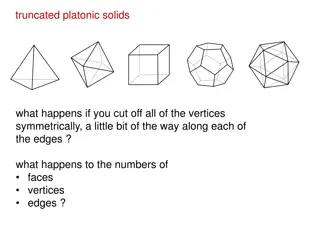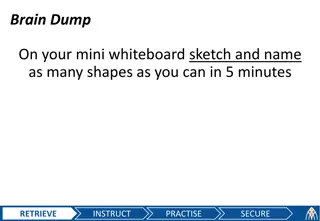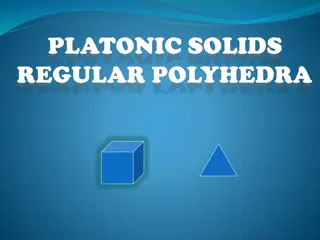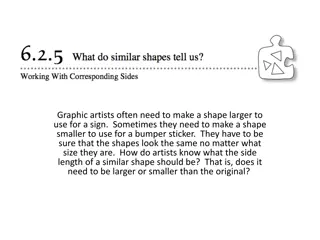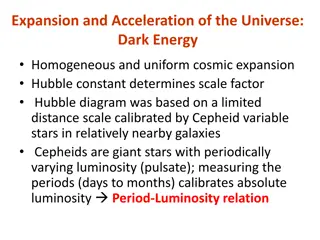Exploring Platonic Solids: Shapes that Define the Universe
Delve into the world of Platonic solids, five unique geometric shapes that have fascinated mathematicians and philosophers throughout history. Discover the general characteristics of each solid - Tetrahedron, Cube, Octahedron, Dodecahedron, and Icosahedron - and unravel the ancient Greeks' profound observations on these fundamental components of the physical universe.
Download Presentation

Please find below an Image/Link to download the presentation.
The content on the website is provided AS IS for your information and personal use only. It may not be sold, licensed, or shared on other websites without obtaining consent from the author. Download presentation by click this link. If you encounter any issues during the download, it is possible that the publisher has removed the file from their server.
E N D
Presentation Transcript
By: Blaire Miran, Najah Soudan, and Jordan Tapp PLATONIC SOLIDS PRESENTATION
Investigation Question What are the general characteristics of platonic sides and why do they work?
History on Platonic Solids Discovered by the Ancient Greeks Called the Platonic Solids after the Ancient Greek Philosopher Plato (430 B.C.) Pythagoreans already knew about the tetrahedron, cube, and dodecahedron (by 450 B.C.) Theaetetus added the octahedron and the icosahedron Plato believed that the five solids were fundamental components of the physical universe
What are the five Platonic Solids?
CHARACTERISTICS ABOUT EACH PLATONIC SOLID
Tetrahedron 3 triangles meet in each point It has four faces It has four vertices It has 6 edges The net has 4 faces, 9 edges, the edges that have the dotted lines are the ones that you bend Equations: Surface area= 3? ???? ????? 2 Volume= ( 2) / 12 ? (???? ????? )3
Cube There are three squares that meet at each point 6 faces 8 vertices 12 edges The net has 6 faces, 24 edges, 4 dotted edges that get folded over, Equations: ??????? ???? = 6 ? (???? ????? )2 ?????? = (???? ????? )3
Octahedron 4 triangles meet at each point 8 faces 6 vertices 12 edges The net has 8 faces, 24 edges, and 7 of the edges bend over to form the shape Equations: ??????? ???? = 2 ? 3 ? (???? ????? ) 2 ?????? = ( 2) ? ???? ????? 3 3
Dodecahedron 3 pentagons meet at each point 12 faces 20 vertices 30 edges The net has 12 faces, 45 edges, and 11 of the edges bend over to form the shape Equations: ??????? ???? = 3 ? 25 + 10 ? 2 5 ? (???? ????? ) ?????? = 7 ? 5 ? (???? ???? )3 15 +
Icosahedron 5 triangles meet at each point 20 faces 12 vertices 30 edges The net has 20 faces, 60 edges, and 19 edges bend over to from a net Equations: ??????? ???? = 5 ? 3 ? ???? ????? 2 3+ 5 12????? ????? 3 ??????=5 ?
Comparison of all Platonic Solids Platonic Solid F=# faces E=# edges V=# vertices Which polygon ? Interior angle of polygon # Faces at vertex How many edges meet at vertex Sum of interior angles at vertex Tetrahedron 4 6 4 Triangle 60 3 3 180 Cube 6 12 8 Square 90 3 3 270 Octahedron 8 12 6 Triangle 60 4 4 240 Dodecahedron 12 30 20 Pentago n 108 3 3 324 Icosahedron 20 30 12 Triangle 60 5 5 300
Constraints of Platonic Solids 1. The vertices of P all lie on a sphere. 2. All the dihedral angles are equal. 3. All the vertex figures are regular polygons. 4. All the solid angles are equivalent. 5. All the vertices are surrounded by the same number of faces.
Equations Used for Platonic Solid Shapes ? =? ? ??? 2? ? ??? vertices ? =?(? ??? 2? ? ???) 2 edges ? = faces # ????? ?? ?????? Used to find the # of Used to find the # of 2? ? ??? 2? ? ??? Used to find the # of
Euclids Proof of Platonic Solids 1. Each vertex of the solid must be formed by joining three or more faces. 2. The sum of the angles formed by the faces at a vertex must be less than 360 . 3. Since the angles at all vertices of all faces of a Platonic solid are identical, and at least three faces are joined at a vertex, the size of the angle of each face must be less than 360 /3=120 . 4. Regular polygons of six or more sides have only angles of 120 or more. This means that the shape of the face is limited to either a triangle, square, or a pentagon.
Duals What is a dual? Adual is formed from a polyhedron by creating a vertex at the center of each face, and then connecting vertices on adjacent faces. This process is hard for most people to visualize without a model, and even with a static model, it can still seem abstract.
Bibliography http://personal.maths.surrey.ac.uk/st/H.Bruin/image/PlatonicSoli ds.gif http://www.enchantedlearning.com/math/geometry/solids/ http://www.geom.uiuc.edu/~sudzi/polyhedra/platonic.html http://www.mathsisfun.com/geometry/platonic-solids-why- five.html http://mathworld.wolfram.com/PlatonicSolid.html http://home.adelphi.edu/~stemkoski/mathematrix/platonic.html http://www.wfu.edu/~parslerj/math165/platonic-inclass.pdf http://www.mathsisfun.com/platonic_solids.html http://debraborkovitz.com/2013/04/duals-of-platonic-solids- videos/ http://www.santarosa.edu/~gsturr/M10/Platonic_Solids.pdf
